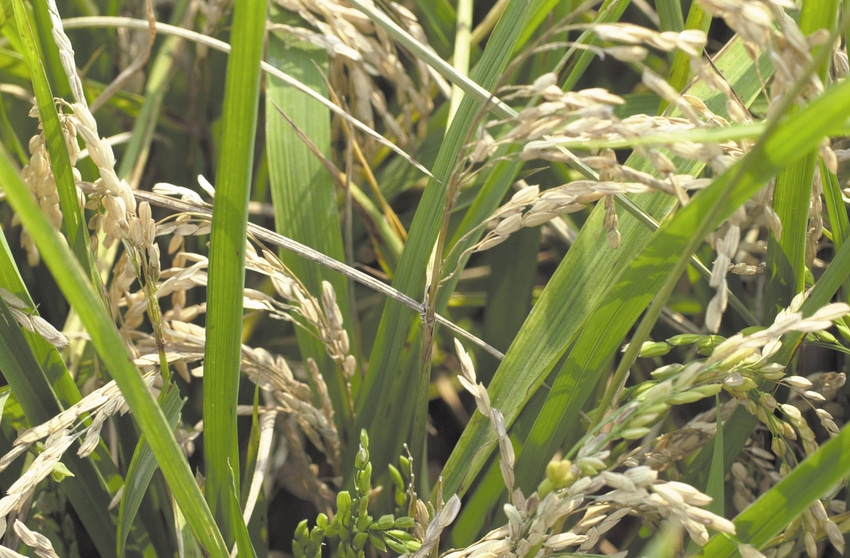
It is Sept. 11 and having already watched the rains generated by Hurricane Gordon sweep over the Arkansas’ roce crop, Jarrod Hardke stands beneath gray skies and misting clouds. The Arkansas Extension rice specialist sums up the last few weeks of the growing season: “The weather has been weird."
“For the most part, growers were just getting back to normal yesterday. Then, shockingly, today there’s bad weather coming up from the south. It’s sprinkling right now. Where did that come from? It wasn’t on any forecast I saw. Yet, it’s overcast and rain is falling in scattered areas from Memphis south. We thought this week would give us a break and we’d have a mix of cloudy mornings and sunshine.”
Even after the Gordon rains “our rice still largely looks okay. Obviously, the ground is wet and growers are just diving in to make harvest progress. The grain moisture level is not perfect, but it’s good enough to do that. So, we’re having to mud the crop out a bit more and that’s slowing things down.
“Some of the rice may not be down, but it’s sinking in places. There are some flattened spots in fields – mostly in the Prairie and south where some of the heavier rainfall was. Those spots weren’t caused by wind but are strictly due to the rain that just kept coming and weighed the plants down.”
Harvest
Overall, all of that means the state’s rice harvest is behind schedule.
“Mainly, that’s because of the weather,” says Hardke. “The crop hasn’t dried out, matured and cured out as fast as it should have because August was ‘flip-flopped.' By that I mean normally the first two weeks of August along with the last two weeks of July are the hottest 30 days of the year.
“This year, while it was still warm, we kind of got a cool down during that period. The last two weeks of August were the typical low-90s, very hot and humid weather that usually happens the first two weeks of the month. It worked in reverse.”
A dry spell would do wonders for morale.
“We’re doing okay but we need a good run of seven to 10 days of dry weather to really put a dent in harvest. Of course, now we’ve got more storms brewing and potentially headed our way. (Tropical Storm) Isaac is supposed to come into the Gulf of Mexico. Will it hit somewhere that’ll impact the Mid-South?
“With all that’s happening we really need to make some progress. We’re probably between 30 to 40 percent harvested.”
Yields and nights
What about yields?
“So far, yields have been very good and people are happy. This season was one of the grassiest crops most folks can remember. I kept hearing ‘there’s so much grass this crop isn��’t going to cut that well.’ But I was thinking ‘I don’t know what rice field you’re talking about because the one I just walked out of looks like it’s going to cut a bunch of rice. I’m not saying there’s no drag from the grass, but there’s a lot of rice out here.’”
The rice crop looks to be strong but don’t expect too much.
“I don’t think it’ll be record-setting but I wasn’t expecting that anyway with the acreage we have this year. Setting records is extremely difficult anytime we get over 1.4 million acres. Once you get to that level, rice starts going onto okay ground but you’re moving off the prime, high-yield production fields.”
How has Provisia done in this year’s weedy conditions?
“One thing I can say is I haven’t had to look at much Provisia rice because it’s done a good job. Extension specialists usually get to talk about problems. The conversations this year have usually been me talking to someone about a problem and at the end they’ll tag on ‘oh, by the way, my Provisia looks good.’
“Folks have also been happy with the cost of control – not only of weedy rice but barnyardgrass populations resistant to other modes of action.”
Hardke says this season’s nighttime temperatures teetered on the razor’s edge.
“For a while, we toed the line on nighttime temperatures around the 75 degree mark for a low. From there and up is the zone of concern. We hung around that level in early July and then caught a break with some rains that took some of the edge off the heat. That was a great thing for the remainder of our flowering, pollination and grain-fill.
“The overall milling quality numbers I’m hearing so far are very good.”
About the Author(s)
You May Also Like




